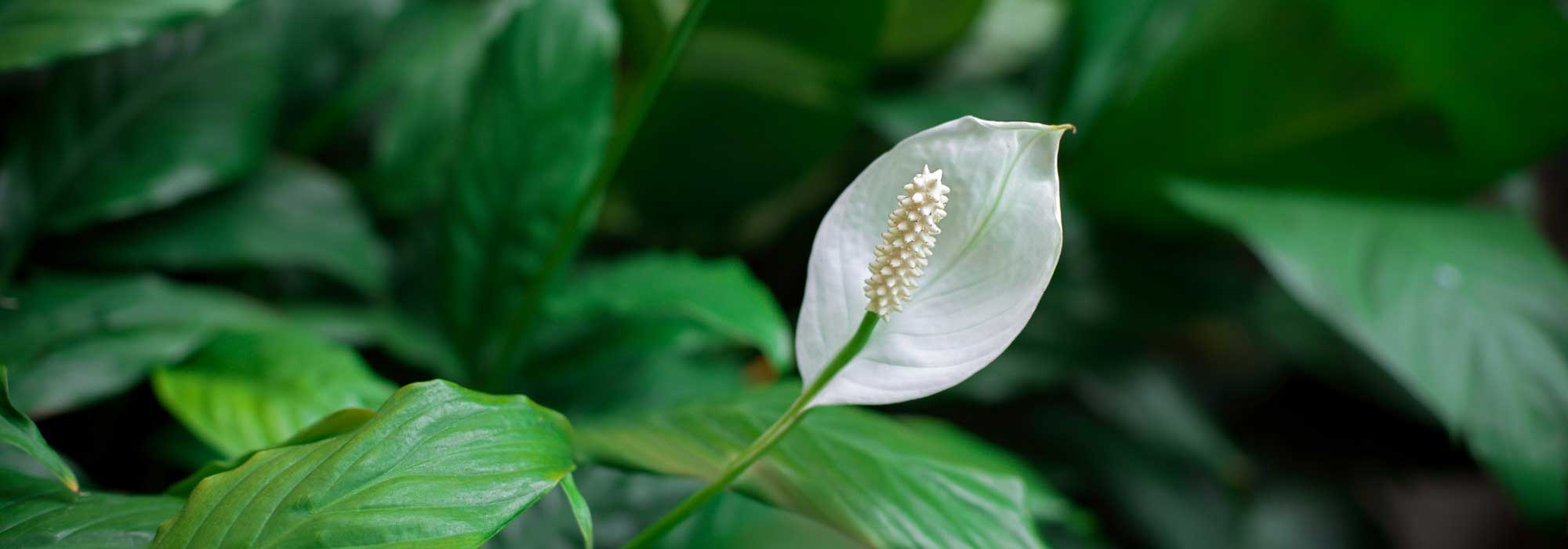
Moon flower, Spathiphyllum : growing, caring
Contents
Moon flower in a nutshell
- Spathiphyllum is a superb indoor plant with large, dark green, glossy, and veined leaves.
- It regularly produces tall, elegant white flowers.
- It is a low-maintenance and easy-to-care-for plant.
- Its flowering can last several weeks and often occurs multiple times a year.
- Its elegant and compact silhouette allows it to blend harmoniously into all styles of decor.
- Air-purifying plant, it has benefits for air purification and helps to reduce indoor humidity.
A word from our expert
The Spathiphyllum, also known as “peace lily”, is a highly valued houseplant for its lush foliage and delicate flowering. Native to the tropical forests of Central and South America, as well as some regions of Southeast Asia, the Spathiphyllum belongs to the family of Araceae. This elegant plant captivates with its generous deep green foliage and its characteristic white flowers that resemble callas, featuring an immaculate spathe surrounding a central spadix.
Thanks to its compact habit and refined appearance, the Spathiphyllum fits well in any room of the house or in an office, adding a soothing green touch. This easy-care plant is an ideal choice for beginner gardeners, although it is also suitable for the more experienced. It is one of the few houseplants that flowers very easily, sometimes several times a year. As a bonus, this air-purifying plant has numerous benefits by helping to purify the air and absorbing ambient moisture.
We reveal all the secrets of the Spathiphyllum, the different varieties, and our tips for successful cultivation!
Description and Botany
Botanical data
- Latin name Spathiphyllum wallisii
- Family Araceae
- Common name Moon flower, Peace lily
- Flowering From spring to autumn, or even all year round
- Height Generally between 40 cm and 1 m
- Sun exposure Bright, without direct sunlight
- Soil type Light, rich and well-drained
- Hardiness Tender (minimum 13-15 °C)
The Spathiphyllum is a herbaceous perennial plant belonging to the Araceae family, just like anthuriums and philodendrons. Its scientific name comes from the Greek spathê (spathe) and phyllon (leaf), referring to its white inflorescences shaped like a spathe that resemble a leaf.
The Spathiphyllum is native to the humid tropical forests of Central America, South America, and some regions of Southeast Asia. It is found notably in Colombia, Venezuela, Panama, and the Philippines. It naturally grows in the shade of undergrowth, in a warm, humid, and low-light atmosphere. This tropical origin explains its moisture needs and preference for filtered light.
The plant adopts a dense and elegant tufted habit. The leaves grow directly from the base, forming a compact and upright rosette. Depending on the varieties, the Spathiphyllum can measure from 30 cm to over a metre in height. There are dwarf varieties, such as ‘Sweet Chico’, ideal for small spaces, and larger varieties, such as ‘Sensation’ or ‘Mauna Loa’.
The foliage of the Spathiphyllum is one of its major attractions. Evergreen and tough, the leaves are long, lanceolate, and display a deep, glossy green. They are borne on long petioles and have a well-defined central vein, giving them a beautiful structure. Some varieties stand out with lighter or variegated foliage, such as ‘Domino’ or ‘Diamond Variegata’, which feature beautiful cream marbling.
The foliage also reflects the plant’s health: dull or drooping leaves often indicate excess or lack of water, air that is too dry, or inappropriate exposure.
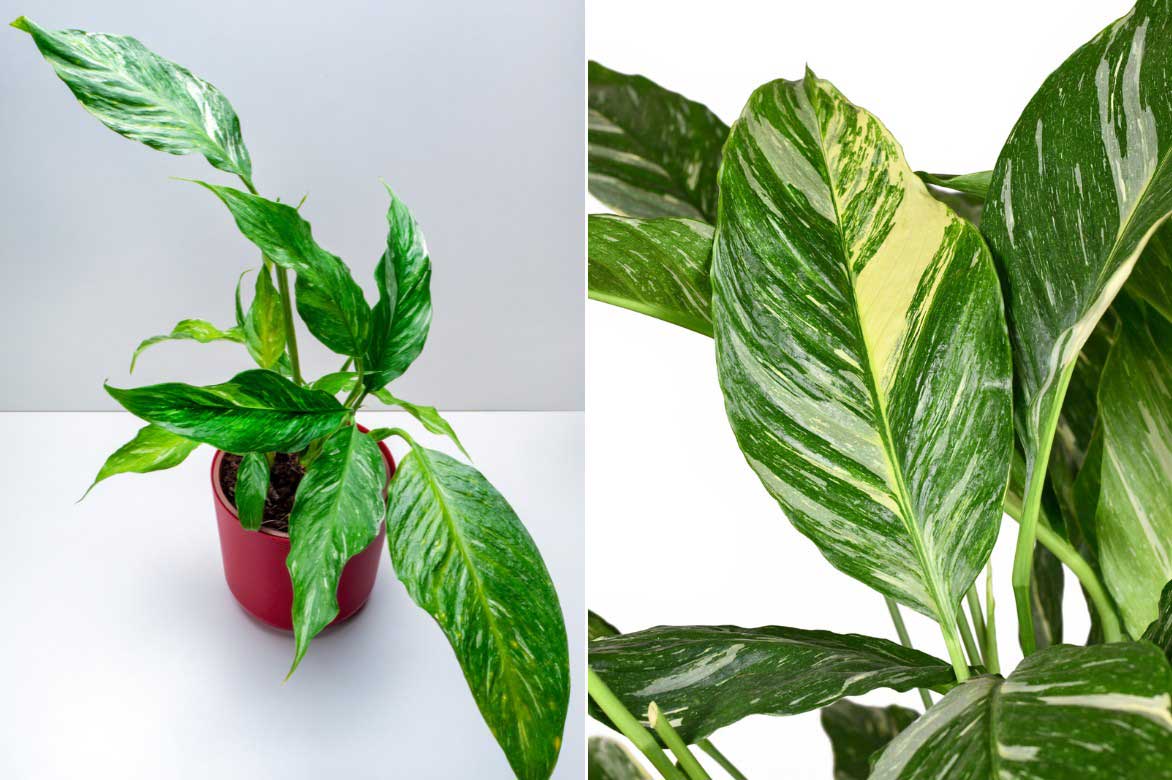
Some Spathiphyllum are distinguished by their variegated foliage: here, the varieties ‘Domino’ and ‘Diamond Variegata’
The flowering of the Spathiphyllum can occur several times a year, especially if the plant is well cared for. It consists of a spadix, a sort of upright spike that is white or cream, surrounded by a white spathe, slightly fragrant, which opens elegantly like a rolled leaf. This spathe is not a flower in the strict sense, but a bract intended to attract pollinators.
The spathe remains white for several weeks, then gradually takes on a greenish hue before wilting. This does not mean that the plant is sick, but simply that the flowering is coming to an end. Some varieties are more floriferous than others. For example, ‘Sweet Chico’ and ‘Cupido’ offer abundant flowering over a long period, while ‘Sensation’ focuses more on the size of the foliage.
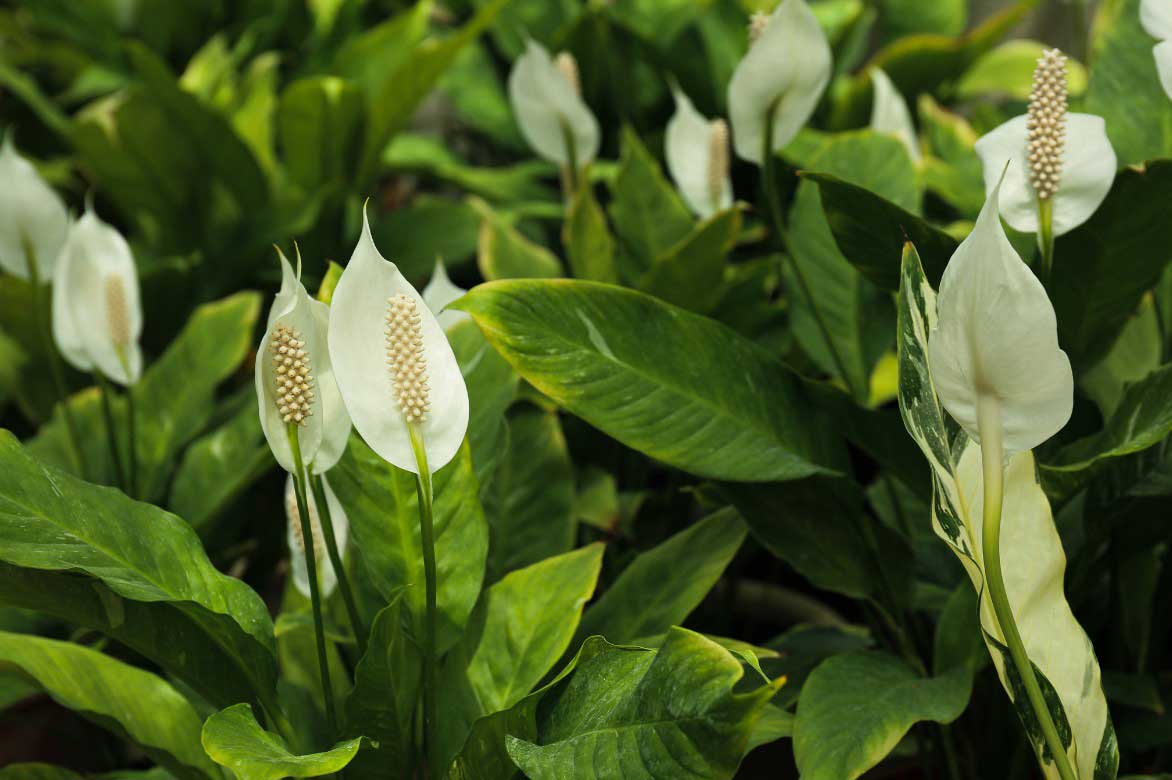 The Spathiphyllum offers particularly elegant white flowering
The Spathiphyllum offers particularly elegant white flowering
The genus Spathiphyllum includes about forty species, but the most commonly cultivated is Spathiphyllum wallisii. In addition to these species, there are many horticultural varieties developed for their size, flowering, or the shape of their foliage. Here is an overview of the main species and varieties:
- Spathiphyllum wallisii : This is the most widespread species and the one most often found as a houseplant. Relatively compact (30 to 60 cm in height), it offers abundant flowering with elegant white spathes. It is very tolerant of low light, making it an excellent plant for poorly lit rooms.
- Spathiphyllum ‘Mauna Loa’ : A variety derived from S. wallisii, very popular. It is distinguished by large glossy leaves and inflorescences that can reach 15 to 20 cm. It is often chosen for offices or large living spaces due to its beautiful stature.
- Spathiphyllum ‘Sensation’ : This is the largest of the cultivated varieties, reaching up to 1.20 m in height. Its large striated leaves are a deep dark green, and its flowers are spectacular. It is perfect for large living rooms or bright halls.
- Spathiphyllum ‘Sweet Chico’ : A compact and floriferous variety, very suitable for small spaces. It produces many flowers over a long period, and its leaves are slightly thinner than those of other varieties.
- Spathiphyllum ‘Domino’ : Highly valued for its variegated foliage, ‘Domino’ features white marbling on green leaves, making it an original and decorative choice. It remains medium-sized, around 40-50 cm.
Each variety has its specific characteristics, but they all share the same basic needs in terms of light, humidity, and care. The choice will therefore depend mainly on the available space, the foliage (variegated or not), and the desired flowering frequency.
The Spathiphyllum is not hardy. It does not tolerate temperatures below 13 to 15 °C. This is why, in temperate climates, it is grown exclusively indoors or in greenhouses. It also fears drafts and sudden temperature changes.
Often cultivated for its understated aesthetics and its ability to flower even in the shade, the Spathiphyllum is one of the few houseplants to offer generous flowering without requiring direct light.
The Spathiphyllum is also recognised for its purifying virtues or benefits, according to certain studies conducted notably by NASA. It is said to be capable of purifying indoor air by absorbing certain toxic substances such as benzene, formaldehyde, and trichloroethylene.
Main species and varieties of moonflower
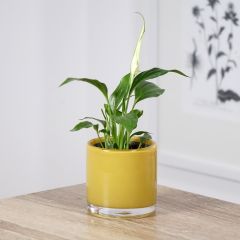
Spathiphyllum wallisii Tanni - Peace lily
- Période de floraison June to October
- Hauteur à maturité 60 cm
Planting Spathiphyllum Indoors
Where to install the Spathiphyllum?
The Spathiphyllum is a tropical plant that prefers bright spots without direct sunlight. Soft, filtered light, such as that through a sheer curtain, is ideal. It can also tolerate semi-shaded situations, making it a very adaptable plant. It is best to avoid full sun exposure, which can scorch its foliage, as well as overly dark locations that will reduce its flowering. The ideal temperature is between 18 and 25 °C. It is sensitive to cold, draughts, and sudden temperature changes. It will easily find its place in a living room, a bright bathroom, or an office.
When to plant it?
As the Spathiphyllum is grown indoors, it can be planted or repotted throughout the year. However, spring is the most favourable time, as the plant then enters its active growth phase. This allows it to better adapt to its new environment.
Repotting the Spathiphyllum is recommended every two years, or as soon as the plant seems cramped in its pot.
How to plant it?
Choose a pot with drainage holes to avoid water stagnation. The diameter of the pot should be slightly larger than that of the previous one.
As for the substrate, the Spathiphyllum appreciates light, well-drained soil rich in organic matter. The ideal is to plant it in a mix consisting of 2/3 indoor plant compost and 1/3 perlite or coarse sand to improve drainage.
Here are the steps to plant it properly (this also works for repotting the Spathiphyllum):
- Place a layer of clay balls or gravel at the bottom of the pot.
- Then add some of the substrate to the pot.
- Gently remove the Spathiphyllum from its original pot.
- Place it in the new pot, in the centre, ensuring not to bury the collar.
- Fill in with the prepared substrate, then lightly compact it.
- Water generously.
Position the plant in a bright spot and maintain a constant moisture level in the substrate (without excess). Moderate and regular watering will encourage rooting.
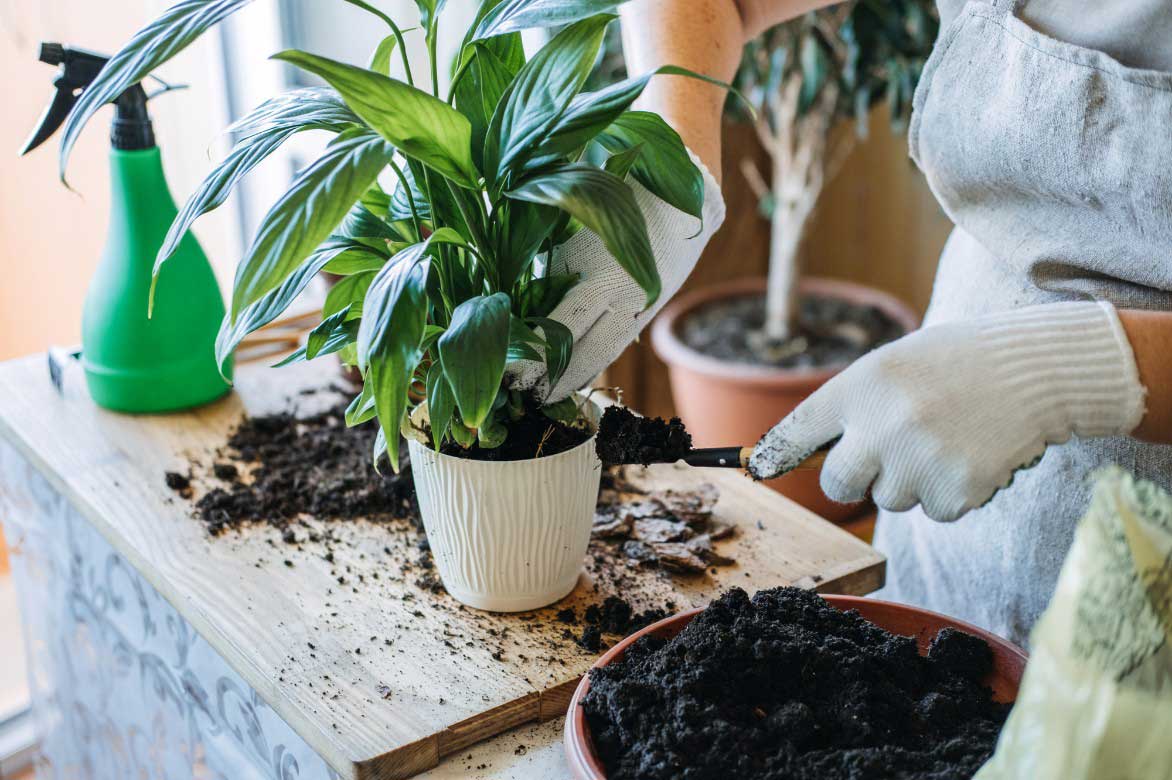
Caring for Spathiphyllum
Caring for Spathiphyllum is relatively simple, making it a highly appreciated houseplant. With a few regular gestures and particular attention to its needs, it will provide you with vibrant foliage and generous flowering.
Watering the Spathiphyllum
The Spathiphyllum enjoys slightly moist soil, without excess. Moderate but regular watering is therefore recommended.
-
During the growth period (spring-summer): water twice a week, allowing the top layer of the potting medium to dry out between waterings.
-
During the resting period (autumn-winter): reduce watering to once a week, or even every 10 days, depending on the ambient temperature.
It is advisable to use room temperature and non-calcareous water (rainwater is ideal). Excess water is one of the main dangers for this plant: always empty the saucer after each watering to prevent root rot.
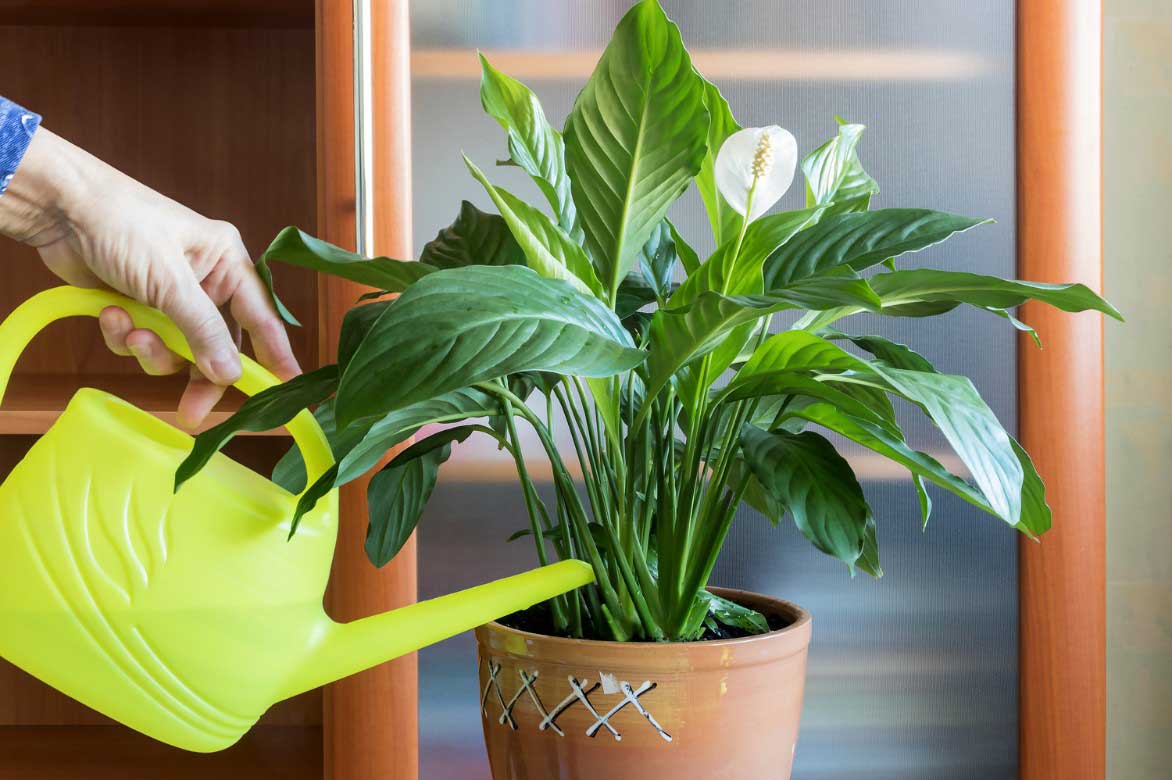
Remember to water your Spathiphyllum regularly
Ambient Humidity
Originating from tropical environments, the Spathiphyllum appreciates a humid atmosphere. In a dry interior, especially in winter with heating, we recommend regularly misting the foliage with non-calcareous water. You can also increase ambient humidity by placing the pot on a bed of moist clay balls (without direct contact with water) or by using a humidifier. Similarly, feel free to group several plants together to create a more humid microclimate.
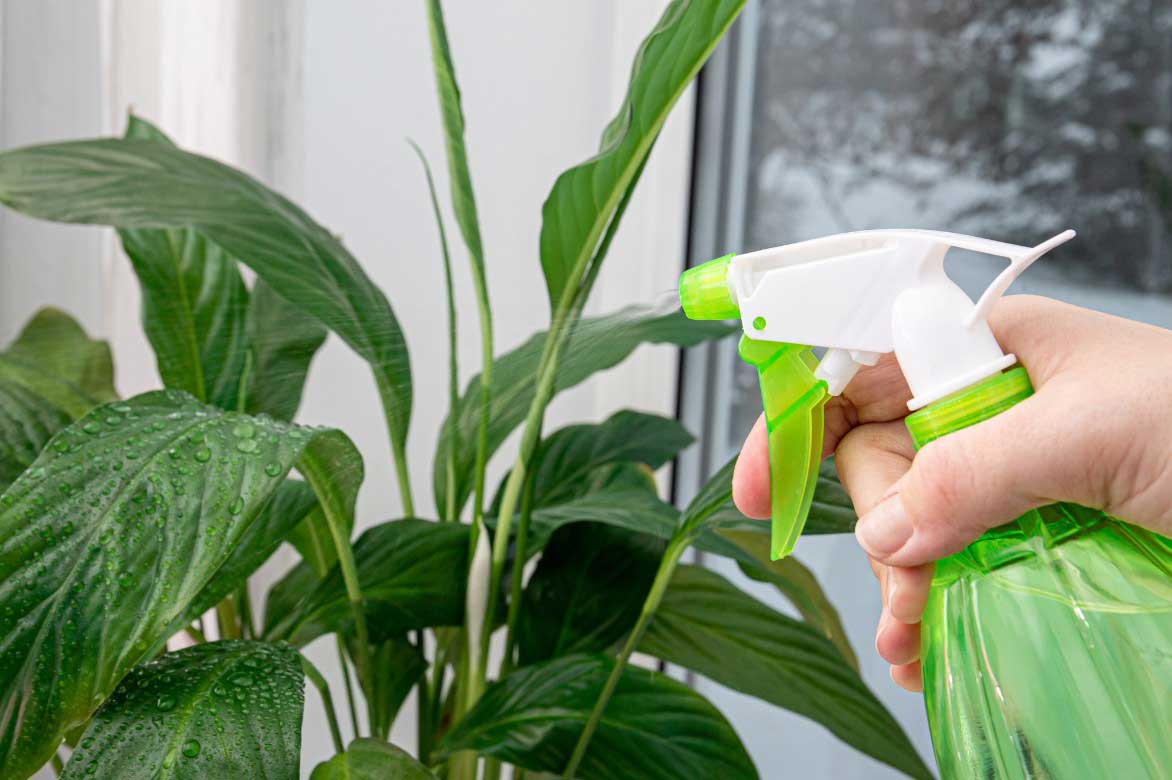
Don’t hesitate to mist the foliage from time to time
Cleaning the Foliage
Leaves quickly accumulate dust, which can hinder photosynthesis. Clean them gently with a damp cloth or occasionally rinse them under a light warm shower. Also, as soon as you see yellow or dry leaves, feel free to remove them by cutting them at the base.
Fertilisation
Apply fertiliser for flowering plants every 15 days during the growth period (from April to September). Preferably use a liquid fertiliser diluted in the watering water. An excess of nitrogen can promote foliage development at the expense of flowers, so ensure a good NPK balance (nitrogen, phosphorus, potassium). Stop fertiliser applications in winter.
Diseases and pests
Spathiphyllum is generally a resilient plant, but it can sometimes be affected by certain diseases or pests, especially when its growing conditions are inadequate. It is therefore important to know how to spot signs of stress and act quickly.
Root rot is one of the most common problems. It occurs when the potting mix remains constantly waterlogged due to overwatering or insufficient drainage. The leaves turn yellow, the plant wilts, and the roots take on a brownish colour and a soft texture. In this case, it is advisable to remove the plant from its pot, eliminate the damaged roots, and then repot it in a healthy, light, and well-draining substrate. Watering should then be adjusted.
Brown or yellow spots on the leaves may appear when Spathiphyllum receives too much direct light, particularly in summer behind a window, or when using hard water for watering or misting. To remedy this, simply move the plant to a bright location, but protected from direct sunlight, and use non-hard water, such as rainwater or filtered water.
Regarding pests, scale insects can sometimes invade the plant. They are recognised by their small cottony clusters often found on the stems or in the leaf axils. One solution is to gently clean the plant with a cloth soaked in 70° alcohol, or to apply a natural treatment based on black soap.
Red spider mites can also attack the foliage, especially if the ambient air is too dry. Their attacks manifest as leaves punctuated with small discoloured spots and the presence of fine webs. Increasing the ambient humidity and regularly showering the foliage can be enough to halt their development. In case of a significant infestation, the use of an organic acaricide is recommended.
Finally, aphids, although less common, can appear on young shoots. They cause leaf distortion and secrete honeydew, a sticky substance. A treatment with black soap or neem oil is generally effective in eliminating them.
Regular observation of your Spathiphyllum and appropriate care can help prevent most of these problems.
How to propagate peace lilies?
Multiplication of Spathiphyllum is mainly done by clump division. This simple and effective method allows for faithful reproduction of the mother plant while providing it with a bit more space to continue growing vigorously.
When to divide Spathiphyllum?
The best time to divide a Spathiphyllum is in spring, during repotting, when the plant comes out of its resting period and resumes its growth. This gives it every chance to settle well into its new pot.
How to divide Spathiphyllum?
Here are the steps to successfully divide your Spathiphyllum:
-
Carefully remove the plant by gently taking it out of its container. If the root ball is very compact, do not hesitate to lightly tap the pot or cut it if it is made of soft plastic.
-
Separate the clumps by identifying well-formed rosettes with their own roots. If necessary, use a clean knife to cut the root ball without damaging the main roots.
-
Gently detach the roots around each division to free the clumps without breaking them.
-
Replant each division in an individual pot containing a mix of potting soil for houseplants and perlite or coarse sand to improve drainage.
-
Water moderately after planting, then place the young plants in a bright location, out of direct sunlight.
-
Maintain good ambient humidity during the first few weeks to encourage rooting and resumption of growth.
Division not only allows you to multiply your Spathiphyllum but also to rejuvenate a plant that has become too bulky or whose centre is starting to thin out.
Alexandra explains this in more detail in the tutorial: How to multiply Spathiphyllum?
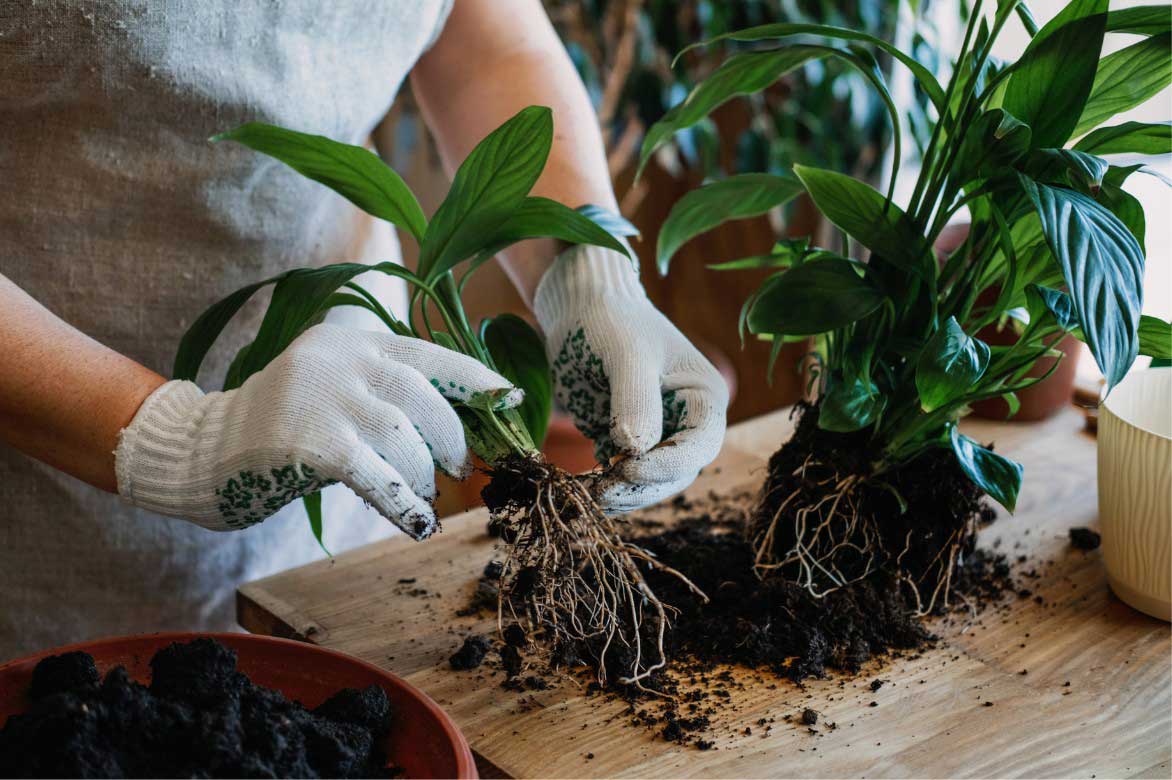
When your Spathiphyllum becomes too dense, do not hesitate to divide it
How to showcase and pair Spathiphyllum?
With its lush foliage and elegant white flowers, Spathiphyllum easily fits into many interior styles, whether you use it alone as a centrepiece or in combination with other plants.
In a plant composition, Spathiphyllum pairs particularly well with other tropical houseplants that enjoy the same light and humidity conditions. It forms a harmonious duo with the Calathea, whose variegated leaves contrast beautifully with the solid green of Spathiphyllum. It can also be associated with the Philodendron or the lobed foliage of the Monstera, to create a very trendy jungle effect.
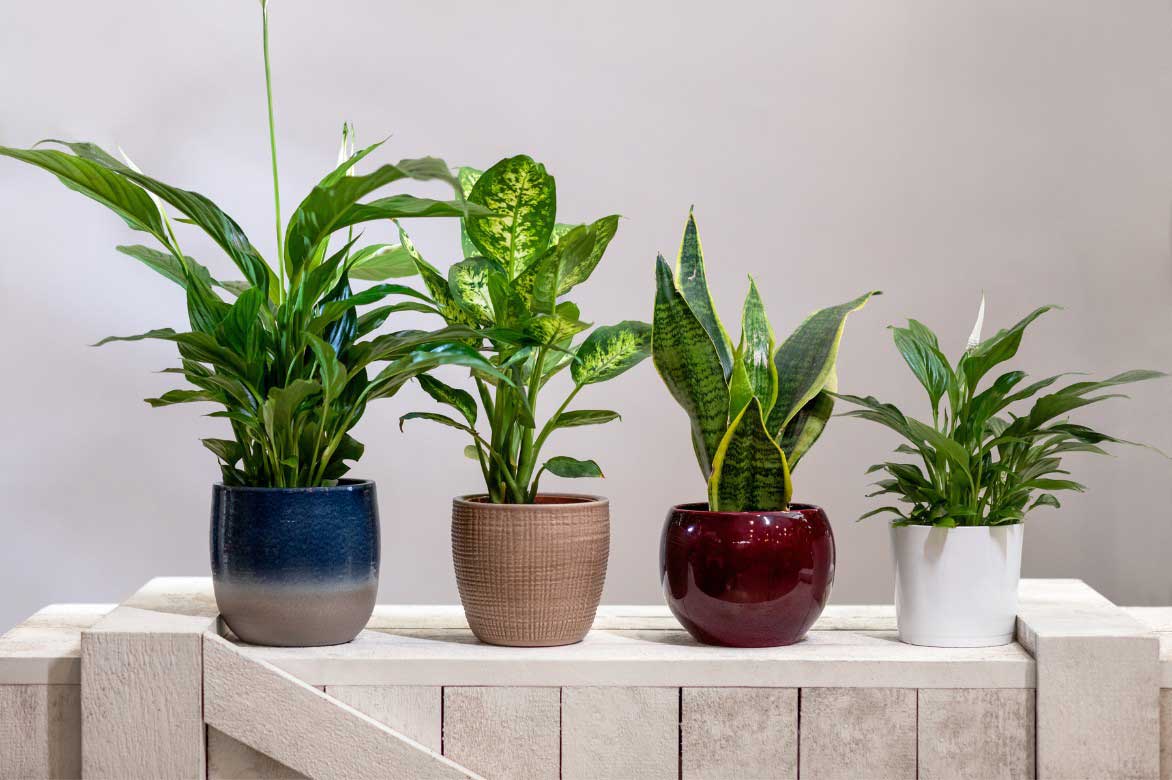
Spathiphyllum, Dieffenbachia and Sanseveria
The Ficus elastica (rubber plant) or Dracaena are also good companions: their more upright habit balances the rounded silhouette of Spathiphyllum. For a zen or minimalist atmosphere, it can be paired with Phalaenopsis orchids, whose delicate flowering and humidity needs are similar.
In a well-lit bathroom, it pairs wonderfully with plants like the Boston fern or Pilea peperomioides, bringing a soft and soothing atmosphere. To enhance its air-purifying effect, it can be placed alongside other filtering plants like chlorophytum.
Finally, in an individual pot on a piece of furniture, in a stylish cache-pot or suspended high up, Spathiphyllum can stand alone, whether for a contemporary, bohemian, or more classic interior.
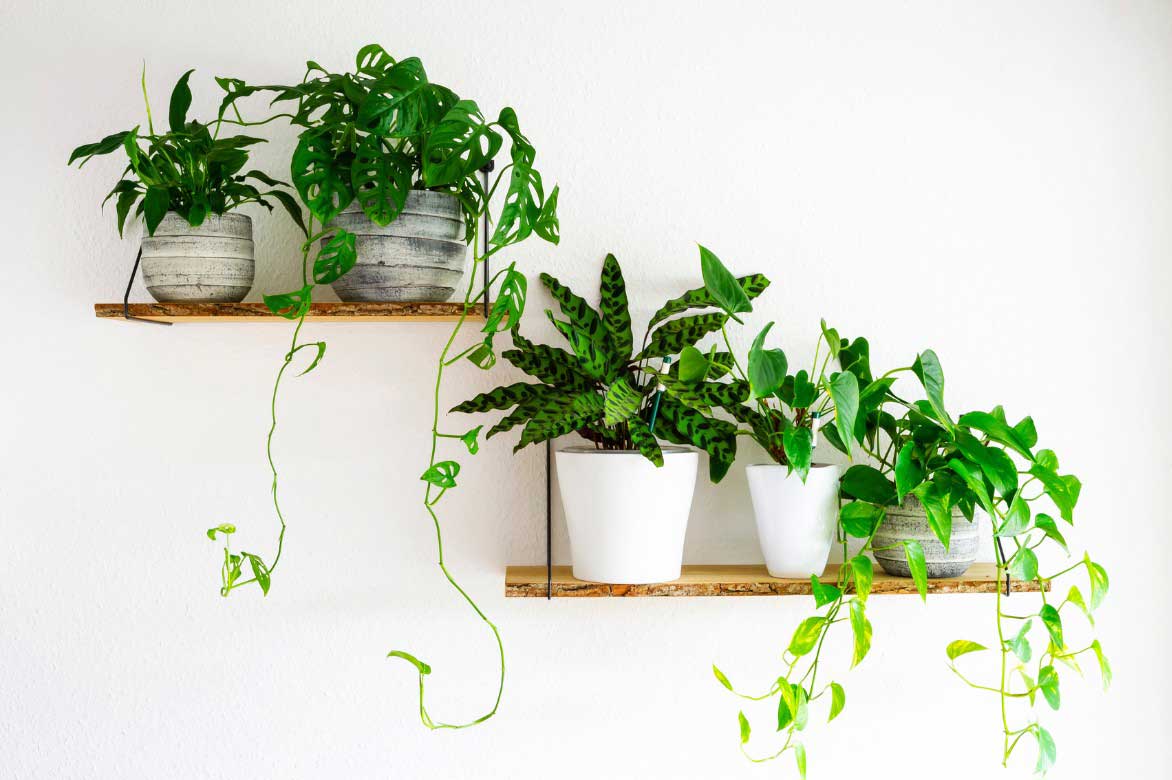
Spathiphyllum, Monstera, Calathea and Pothos
- Subscribe!
- Contents
































Comments